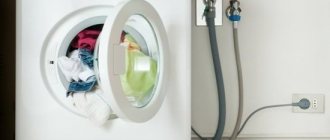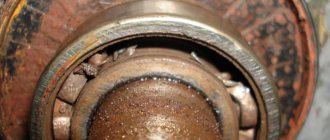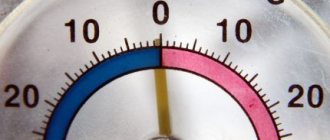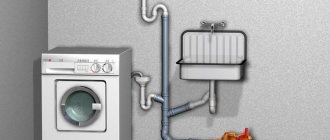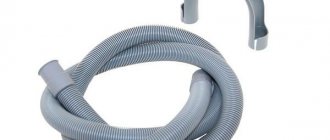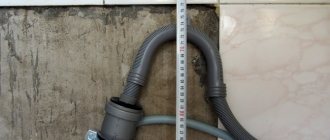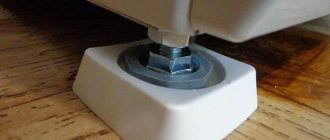The simplest option for draining water is a hose installed on the edge of the sink or bathtub. Unsightliness and the need to clean the bathtub after each wash, plus high humidity in the bathroom or kitchen, are not in favor of this method. In addition, due to circumstances, the drain hose may fall out of the bathtub or sink, and cause expensive repairs to the neighbors’ apartment on the lower floor. A siphon for a washing machine is a reliable and proven way to connect the unit to a drain or sewer system.
Required Tools
To work with household appliances, you need to be prepared; you need to have on hand all the necessary tools that will be useful in your work.
- Various screwdrivers (you can use a universal model).
- A pipe cutter needed to cut into a pipe.
- Welding machine for plastic.
- Sealant.
- Corrugated hose.
- Plastic tee.
The nuances of connecting to the sewer
If the washing machine does not have a water drainage check valve, then the height of the hose should be as specified in the instructions.
It is recommended to purchase a sewer siphon; in this case, the outlet hose can be connected above the knee level. This connection method is the best protection against leakage.
The easiest way to connect is to secure the drain pipe in the sink or bathtub. But in this case, the pipe may slip to the floor, so it is better to abandon this option.
The outlet hose should be located on the back wall of the washing machine and should not have any kinks or bends.
Connection via siphon
This is a very common and reliable method for which you need to use a siphon. The drain pipe is connected to the sink siphon; if it has only one pipe, then you need to use a conductor.
- This connection method has one drawback: an unpleasant sewer smell can get into the washing machine drum.
- To prevent this from happening, you need to use a siphon with an air barrier, which promotes stagnation of water.
- You can also purchase a siphon with a check valve; this is the most ideal option that will protect the washing machine from unpleasant odors.
A large assortment of siphons makes it possible to choose the appropriate option in terms of cost and design.
Description of the device and operating principle
Siphons are considered useful accessories that help reduce the load on pumps. In addition, they eliminate many of the hassles associated with system maintenance.
Structurally, the device is designed to form a so-called water seal. That's why experts say that this is a really necessary detail.
At its core, a siphon looks like a pipe with a curved channel. A certain amount of liquid is used inside, due to which the escape of gases after draining is completely prevented. The water plug prevents excess particles from getting inside the main parts of the system.
It is now difficult to imagine connecting washing machines to a drainage system without the use of siphons. These same devices make it possible to connect other equipment such as sinks, showers, and so on.
The devices are made of plastic, because it is protected from rust even when exposed to moisture. Brass and copper are also used, but less frequently.
Direct connection to pipe
In some cases, a direct connection of the drain pipe to the sewer pipe is made. To do this, you need to prepare in advance a special ring with a seal, which will help connect a narrow pipe to a wide hole.
This method is used in some cases when there is no sink in the room or the machine is located at a great distance from the siphon.
It is important to maintain the distance between the drain point and the floor; if the pump has more power, then the deviations may be more significant.
- When connecting directly, you should avoid pulling the hose along the floor at a low level, as sewage may fall back into the drum of the washing machine;
- The correct method is a raised vertical outlet from the sewer pipe into which the drain hose is inserted;
The direct connection method is considered more complex and costly than connecting through a siphon. But if the connection is made correctly and reliably, then there will be no problems in operating the washing machine.
Easy connection of the washing machine
The simplest type of connection is to throw the hose over the toilet, bathtub or sink. In this case, you need to use a special plastic hook with latches, which is needed to secure the hose. This method is considered short-term, since it is not particularly reliable.
The disadvantages of throwing a hose include the following points:
- If the water pressure is strong, the hose may break and water will flow onto the floor.
- Children and pets may touch the hose and cause it to fall.
- After washing, the sink or bathtub must be thoroughly washed.
- Unaesthetic appearance.
Using a simple connection method, you need to take a hose whose length does not exceed four meters. A hose that is too long can cause problems such as water stagnation and unpleasant odors.
Installation: some features
If the room is small enough, then owners often have to place the machines downstairs under the sink. In this case, the dimensions of the latter must exceed the dimensions of the device. Then moisture will not get on the equipment.
Siphons are usually chosen with a vertical arrangement. This allows you to ensure that the equipment is as close to the wall as possible. Manufacturers supply such products assembled.
All that remains is to install it in the socket of the outlet network, where the sealing ring is also installed. Do-it-yourself installation allows you to save additional money. The main disadvantage is the need to place the siphon closer to the sink.
Selecting a connection method
All three connection methods are actively used both in houses and in private apartments. The simplest method is a simple connection - throwing a hose into the plumbing, which even a beginner can handle.
But the disadvantages of this method are obvious, so it is better to abandon this idea if possible.
- Experts recommend choosing the most optimal method - connecting through a siphon with a check valve, which is the most reliable and convenient to use.
- If you need to connect to a sewer pipe directly, it is best to seek help from a professional, as this is a rather complex and time-consuming method.
When choosing a connection method, it is best to carefully consider the further operation of the washing machine, and do not forget about the reliability and aesthetic side. It is better to connect the car to the sewer in a way that completely eliminates water leakage and, therefore, damage to repairs or flooding of neighbors.
How is installation done?
Automatic washing machines are expensive types of equipment. Therefore, you must strictly follow the manufacturer's instructions when installing. The higher the cost of the product, the more expensive the repair will be later.
Installing siphons with outlet
Siphons have an appearance much like regular sinks. The only difference lies in the absence of a separate pipe to which the machine is connected. The installation also has a standard scheme, which is used in almost all bathrooms. Sometimes they only change the tube with the fitting, and not the siphon itself, but such options cannot be considered acceptable.
The description of the process will be as follows:
- We remove the old device completely. For this purpose, two plastic nuts are unscrewed, which are responsible for fastening to the drain and other parts. The main thing is not to forget to place a container where dirty water flows.
- The drainage of the sink into the sewer is thoroughly cleaned. Dirt and deposits must be completely removed.
- We install a new siphon. The main thing is to remember to screw the plastic nuts tightly when the work is almost finished.
- We put the hose from the machine on the fitting, which is intended for this.
- The connection is tightened to ensure maximum tightness.
About installing built-in products
The main thing is to think in advance about how the washing machine connects to the sewer. Special siphons for water drainage are built in if the equipment has its own permanent place. The installed product is completely covered using moisture-resistant plasterboard. There should be a tile on top. Only a small outlet should be left outside, through which the hose is connected.
Putting on the nut or tightening it are simple but effective ways to complete the fastening. These types of siphons have the main advantage of maintaining a small distance between the machines and the walls. The connections themselves have an attractive appearance.
Thanks to siphons, pumps are protected from additional loads. Provides complete protection from harmful effects from the sewerage system.
Siphon for washing machine
The siphon is designed to properly drain water and eliminate unpleasant odors. Its design makes it possible to self-clean, and a special siphon for the washing machine also collects small debris that has fallen into the drum of the washing machine.
This is very convenient, because if jewelry accidentally gets into the drum, it can be taken out of the siphon, where it will most likely get stuck with other debris.
- The best option is a siphon with a check valve, which has many advantages and is considered a relatively new model.
- It prevents debris and blockages from getting back into the machine drum, and this is its main advantage.
- Siphons can be made from different materials - brass, cast iron and plastic.
- An inexpensive and relevant option is a plastic siphon, which is suitable for any household appliance.
When installing a siphon, it is necessary to study the instructions for the washing machine, since each model has its own characteristics.
Connected equipment: testing
The quality of the connections is checked for leaks after the work is completed. Bolts, clamps, nuts and other similar elements should be tightened as tightly as possible.
Gaskets with a rubber base should also be positioned evenly inside the holes. The compaction must be uniform along the entire circumference.
After this, all that remains is to turn on the washing machine and select an operating mode so that a sufficient amount of liquid is collected. Afterwards, the mode is changed so that the water is drained as usual. A layer of paper towels or toilet paper is placed where the joints go.
